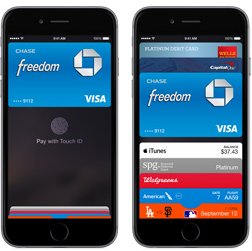Smartphone – With its release of the new iPhone last week, Apple has announced Apple Pay, a new, secure and private electronic mobile payment system. Apple Pay works with the iPhone 6 and iPhone 6 Plus through a new Near Field Communication (NFC) antenna design, a dedicated chip called the Secure Element, and security by means of their proprietary Touch ID fingerprint identity sensor.
Apple Pay will also work with the newly announced Apple Watch, providing Apple Pay functionality to over 200 million owners of iPhone 5, iPhone 5c and iPhone 5s worldwide.
 In making the announcement, Apple CEO Tim Cook said that Apple’s vision is to replace cash and plastic credit cards, noting that there are more than 200 million credit card and debit card transactions processed per day in the US, with consumers spending more than $12 billion every day between credit cards and debit cards. That amounts to “over $4 trillion a year,” he said, adding, “and that’s just in the US”.
In making the announcement, Apple CEO Tim Cook said that Apple’s vision is to replace cash and plastic credit cards, noting that there are more than 200 million credit card and debit card transactions processed per day in the US, with consumers spending more than $12 billion every day between credit cards and debit cards. That amounts to “over $4 trillion a year,” he said, adding, “and that’s just in the US”.
No such system would work without third-party support, and Apple has already lined up an impressive array of credit providers and banks, including American Express, MasterCard and Visa, Bank of America, Capital One Bank, Chase, Citi and Wells Fargo, representing 83% of credit card purchase volume in the US. In addition to the 258 Apple retail stores in the US, point-of-sale retailers that will support Apple Pay include Bloomingdale’s, Disney Store and Walt Disney World Resort, Duane Reade, Macy’s, McDonald’s, Sephora, Staples, Subway, Walgreens and Whole Foods Market. Apple Watch will also work at the over 220,000 merchant locations across the US that have contactless payment enabled.
Here’s how the secure transactions work. When you register a credit or debit card with Apple Pay, a unique Device Account Number is assigned, encrypted and securely stored in the Secure Element on the iPhone or Apple Watch. Each transaction is authorized with a one-time unique number using the Device Account Number and, instead of using the security code from the back of your card, Apple Pay creates a dynamic security code to securely validate each transaction, a process called tokenization. (The actual card numbers are not stored on the device or on Apple servers.)
NFC is a set of short-range wireless technologies, typically requiring a distance of 4cm or less to initiate a connection, and using even less power than Bluetooth. NFC allows users to share small payloads of data between an NFC-equipped phone or tablet and an NFC tag at a point-of-sale terminal, or between two NFC consumer devices. Until the iPhone 6, NFC was supported in phones only on Android devices; by means of the Google Wallet app, an NFC-equipped Android phone enabled secure transactions at hundreds of thousands of merchant locations in the United States.
But there are several key holdouts to both the Apple Pay and Google Wallet ecosystems, most notably, WalMart, 7-Eleven, BestBuy, Target and Lowes, among others who have joined forces in a consortium of retailers called the Merchant Customer Exchange (MCX). The Boston-based mobile-commerce company just last week announced its own brand of a mobile payment network, called CurrentC, which has been launched in a private pilot in select locations across the country. The private pilot will expand through 2014, with regional and national rollouts to follow in 2015.
Why the holdouts? For one, the NFC point-of-sale equipment has been said – by at least one retailer, Best Buy, who tried and then dumped NFC years ago – to cost too much to maintain. Because the MCX solution uses barcodes, retailers using scanners at the point-of-sale have no new equipment in which to invest. Last year, an MCX spokesperson was quoted as saying, “The initial MCX solution will be primarily barcode- and cloud-based, which will allow it to work on the broadest array of smartphones and at a wide range of merchant locations, where bar-code payments can be accepted without major new capital expenses.”
But a large part of the answer is surely the closed ecosystem that hitching your wagon to an Apple device entails. From writing an app for an Apple device, or providing mobile phone service, to providing functionality like mobile TV or an FM radio, Apple has always been in the rather unique position of dictating the business conditions surrounding the commerce associated with or enabled by the iPhone. (Even the simplest function, like a third-party power/interface connector must be licensed by Apple.)
As my colleague Steve Sechrist recently observed in Display Central’s Mobile Display Report, digital payment systems are still in their infancy, despite deployments going back decades. Credit cards are still the tried-and-true consumer vehicle for conducting cashless commerce, and the recent spate of secure information compromises could make a lot of consumers hesitant to trust their card information to yet another online repository.
For all its appeal, Apple’s market share for the iPhone slipped year on year to just 11.7% of the entire market, while Android’s market share increased to 84.7% — which means there are seven Android phones sold for every one iPhone. But Apple does yield a lot of clout in the market, and the iPhone 6 could improve the overall penetration of Apple phones. In the end, Apple is but one player in the mobile commerce market, so it may only be a question of time as to when electronic mobile payment truly takes off. – Aldo Cugnini

